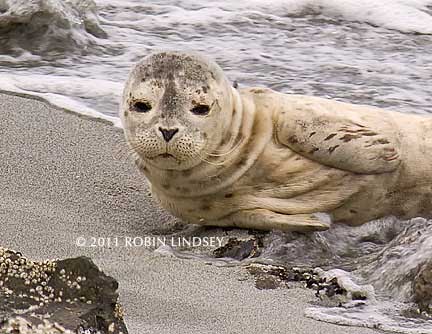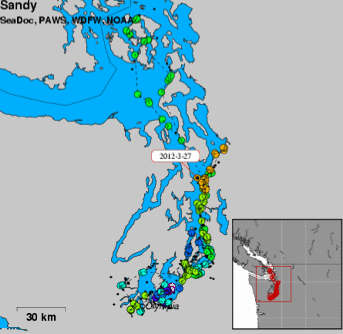Seal pup Sandy drowns in fishing gear
Apr/01/12 07:52 PM

Sandy was only three weeks old, weighing 7.1 kgs (a third of normal body weight for a nursing pup), when she was rescued by Seal Sitters from a West Seattle beach on August 15, 2011 (photo right). She spent a lengthy 5 month rehab at PAWS, but was a robust pup when finally released at a harbor seal rookery in South Puget Sound. Through the combined efforts of PAWS, NOAA, SeaDoc Society and WDFW Marine Mammal Investigations, Sandy was fitted with the satellite tag in order to provide valuable data to researchers. The satellite revealed she stayed relatively close to the release point for the first few days, but then she began taking off on adventures - south to Olympia, north to the San Juans, circling Vashon, back to Olympia and Shelton, up to Edmonds a couple of times. After being in a small pool for so many months, it seemed as though she had the travel bug and appeared to be thriving in the wild (map below shows her travels). The last satellite hit was on the 27th.

Sandy is not the only harbor seal with a West Seattle connection to die from fishing gear. A few days before we rescued her last August, we responded to a dead adult female on Beach Drive. The necropsy showed that the female had given birth within ten days or so and the cause of death was from fishing line and lure, twisting the female’s stomach and causing an agonizing death. A newborn pup we nicknamed Tiny died on another beach the same day as the necropsy. It is not beyond the realm of speculation that Tiny was this female’s pup and that fishing gear caused the death of both animals.
This is truly a very sad day. Special thanks to PAWS’ staff who nursed Sandy back to health and cared for her for so many months. For those of us who participated in her release, we will never forget the joy of seeing her swimming free in the Sound with that little yellow-green satellite hat. SS volunteers and Puget Sound residents signed up to receive SeaDoc Society email alerts and excitedly followed her movements online. To read more about Sandy and view the video of her release back to the wild, click here.
To learn more about the dangers of marine debris and how you can help, click here.
NOTE TO DIVERS:
If you are a diver and come upon animals who have died in derelict gear, we ask two things. First, please take a photograph and email a jpg to us. We will forward the photos to the appropriate person for a corresponding database - this will greatly help assess the true number of animals that perish each year. Secondly, please indicate the location of the derelict gear if you have lat/long finder and we will report it to the Northwest Straits Derelict Fishing Gear Removal Program which estimates that 50,000 animals are entangled and die each year in Washington waters just in shallow water nets and gear (excluding an unknown number in deep-water derelict gear). Harbor seals had by far the highest number of deaths among marine mammals in gear they removed. According to their website :
As of November 30, 2011, the Northwest Straits Initiative has removed 4,081 derelict fishing nets and 2,668 crab pots from Puget Sound, restoring 596 acres of critical marine habitat. Over 241,700 animals, representing more than 240 species, were found entangled in this gear.
Please spread this message among your diving community and make a difference for the marine mammals of Washington. Do not attempt to remove fishing gear - it is extremely dangerous. NW Straits has informed us that a diver drowned in Puget Sound a few years ago on a sport fishing line cleanup.







